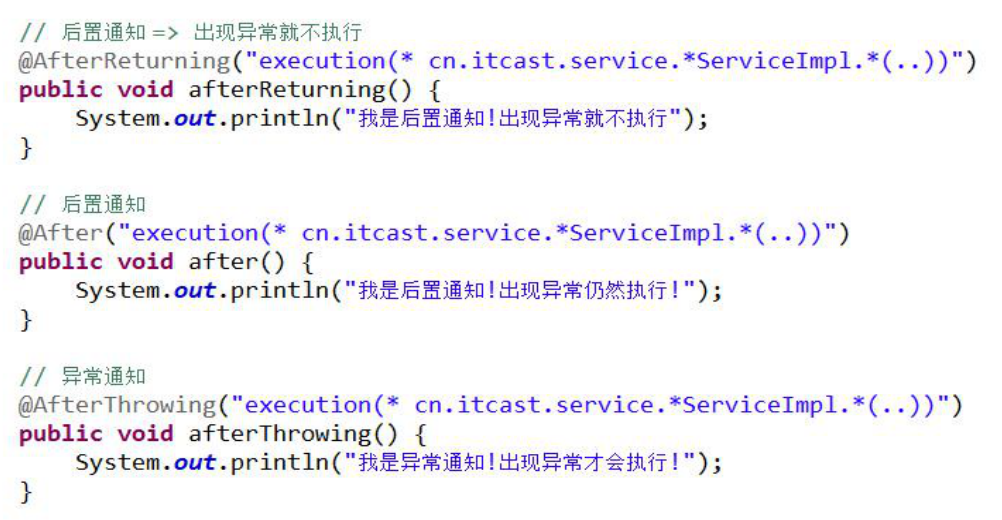Spring框架 aop操作的注解方法 基于aspectj的自动注解aop方法 抽取相同的value="execution(public void cn.itcast.f_aspect.CRUD.*())"
首先是在xml配置文件中配置好对象,然后开启aop的注解方法——即<aop:aspectj-autoproxy></aop:aspectj-autoproxy>
xml代码如下:
<?xml version="1.0" encoding="UTF-8"?>
<beans xmlns="http://www.springframework.org/schema/beans"
xmlns:xsi="http://www.w3.org/2001/XMLSchema-instance" xmlns:context="http://www.springframework.org/schema/context"
xmlns:aop="http://www.springframework.org/schema/aop"
xsi:schemaLocation="
http://www.springframework.org/schema/beans http://www.springframework.org/schema/beans/spring-beans.xsd
http://www.springframework.org/schema/context http://www.springframework.org/schema/context/spring-context.xsd
http://www.springframework.org/schema/aop http://www.springframework.org/schema/aop/spring-aop.xsd">
<!-- 开启注解扫描——对象和属性 -->
<context:component-scan base-package="com.swift"></context:component-scan> <bean id="book" class="com.swift.Book"></bean>
<bean id="adviceBook" class="com.swift.AdviceBook"></bean> <!-- 开启aop注解方法 -->
<aop:aspectj-autoproxy></aop:aspectj-autoproxy> <!-- 这是xml 配置文件中aop操作的方法留下对比
<aop:config>
<aop:pointcut expression="execution(* com.swift.Book.*())" id="pointcut1"/>
<aop:aspect ref="adviceBook">
<aop:before method="before" pointcut-ref="pointcut1"/>
<aop:after-returning method="after" pointcut-ref="pointcut1"/>
<aop:around method="around" pointcut-ref="pointcut1"/>
</aop:aspect>
</aop:config> -->
</beans>
上面有原来xml配置aop的方法,这时已经不用了,用作参考
被增强的类及方法,代码如下:
package com.swift;
public class Book {
public String fun() {
System.out.println("This is Book's fun()..............");
return "This is Book's fun()..............";
}
}
用于增强的类及方法,代码如下:
package com.swift; import org.aspectj.lang.ProceedingJoinPoint;
import org.aspectj.lang.annotation.AfterReturning;
import org.aspectj.lang.annotation.Around;
import org.aspectj.lang.annotation.Aspect;
import org.aspectj.lang.annotation.Before; @Aspect
public class AdviceBook {
@Before(value="execution(* com.swift.Book.*(..))")
public String before() {
System.out.println("This is AdviceBook's before()...............");
return "This is AdviceBook's before()...............";
}
@AfterReturning(value="execution(* com.swift.Book.*(..))")
public String after() {
System.out.println("This is AdviceBook's after()...............");
return "This is AdviceBook's after()...............";
}
@Around(value="execution(* com.swift.Book.*(..))")
public String around(ProceedingJoinPoint proceedingJoinPoint) throws Throwable { System.out.println("This is AdviceBook's front()..............."); proceedingJoinPoint.proceed(); System.out.println("This is AdviceBook's end()...............");
return "This is AdviceBook's around()...............";
} }

类的上边用@Aspect表示切面
方法前用@Before(value="表达式") 其中表达式与之前配置方法相同
最后测试类,代码如下:
package com.swift; import java.io.IOException;
import javax.servlet.ServletException;
import javax.servlet.annotation.WebServlet;
import javax.servlet.http.HttpServlet;
import javax.servlet.http.HttpServletRequest;
import javax.servlet.http.HttpServletResponse; import org.springframework.context.ApplicationContext;
import org.springframework.context.support.ClassPathXmlApplicationContext; import com.swift.Book;
@WebServlet("/test")
public class ServleTest extends HttpServlet {
private static final long serialVersionUID = 1L;
public ServleTest() {
super();
}
protected void doGet(HttpServletRequest request, HttpServletResponse response) throws ServletException, IOException {
response.getWriter().append("Served at: ").append(request.getContextPath());
ApplicationContext context=new ClassPathXmlApplicationContext("aop.xml");
Book book=(Book)context.getBean("book");
//这个返回值,反复试验得出最后浏览上只输出This is AdviceBook's around().
response.getWriter().append(book.fun());
}
protected void doPost(HttpServletRequest request, HttpServletResponse response) throws ServletException, IOException {
doGet(request, response);
} }
其实就一句
response.getWriter().append(book.fun());
网页上返回值为around()中返回值,console控制台得到前后包围所有增强的输出。
如下图:

=============================================================================================
重新整理上边内容
package cn.itcast.f_aspect; import org.aspectj.lang.ProceedingJoinPoint;
import org.aspectj.lang.annotation.After;
import org.aspectj.lang.annotation.AfterReturning;
import org.aspectj.lang.annotation.AfterThrowing;
import org.aspectj.lang.annotation.Around;
import org.aspectj.lang.annotation.Aspect;
import org.aspectj.lang.annotation.Before; @Aspect
public class Myadvice { @Before(value="execution(public void cn.itcast.f_aspect.CRUD.*())")
public void before() {
System.out.println("之前-->开启事务");
}
@Around(value="execution(public void cn.itcast.f_aspect.CRUD.*())")
public void round(ProceedingJoinPoint proceedingJoinPoint) {
System.out.println("之前-->开启事务");
try {
proceedingJoinPoint.proceed();
System.out.println("没有异常,之后-->提交事务");
} catch (Throwable e) {
System.out.println("出现异常,之后--回滚事务");
}finally {
System.out.println("有无异常都执行,之后-->关闭事务");
} }
@AfterReturning(value="execution(public void cn.itcast.f_aspect.CRUD.*())")
public void afterReturning() {
System.out.println("没有异常,之后-->提交事务");
}
@After(value="execution(public void cn.itcast.f_aspect.CRUD.*())")
public void after() {
System.out.println("有无异常都执行,之后-->关闭事务");
}
@AfterThrowing(value="execution(public void cn.itcast.f_aspect.CRUD.*())")
public void afterThrowing() {
System.out.println("出现异常,之后--回滚事务");
}
}
发现每句中的内容一样,如何抽取 value="execution(public void cn.itcast.f_aspect.CRUD.*())"
Spring框架 aop操作的注解方法 基于aspectj的自动注解aop方法 抽取相同的value="execution(public void cn.itcast.f_aspect.CRUD.*())"的更多相关文章
- (spring-第19回【AOP基础篇】)基于AspectJ和Schema的AOP
基于AspectJ就是基于@AspectJ注解,基于Schema就是全部依靠配置文件.那么首先要了解Java注解. Java注解初探 在JDK5.0中,我们可以自定义标签,并通过Java语言的反射机制 ...
- IDEA02 利用Maven创建Web项目、为Web应用添加Spring框架支持、bean的创建于获取、利用注解配置Bean、自动装配Bean、MVC配置
1 环境版本说明 Jdk : 1.8 Maven : 3.5 IDEA : 专业版 2017.2 2 环境准备 2.1 Maven安装及其配置 2.2 Tomcat安装及其配置 3 详细步骤 3.1 ...
- 07 Spring框架 依赖注入(四)基于注解的依赖注入
前面几节我们都在使用xml进行依赖的注入,但是在实际的开发中我们往往偏爱于使用注解进行依赖注入,因为这样更符合我们人的思维,并且更加快捷,本节就来讲述Spring基于注解的依赖注入: 信息注入注解 @ ...
- 关于aop的两种方式-基于注解和基于aspectj
spring的aop确实好用,能够在不影响业务功能的情况下,实现一些低耦合的功能. 而aop又有两种常用的实现方式,一种是用aspectj表达式去匹配,实现全局的配置,表达式还可以使用与或非符号去连接 ...
- Spring @Bean注解 (基于java的容器注解)
基于java的容器注解,意思就是使用Java代码以及一些注解,就可以取代spring 的 xml配置文件. 1-@Configuration & @Bean的配合 @Configuration ...
- Spring框架零基础学习(一):IOC|DI、AOP
文章目录 一.IDEA创建Spring项目 二.Spring: IOC和DI 三.Spring: AOP 参考链接: HOW2J.CN:Spring idea创建一个spring项目 一.IDEA创建 ...
- Spring框架中的Quartz定时任务使用笔记(通过@Scheduled注解的方式实现)
1.修改spring的xml配置信息 applicationContext.xml 三个部分内容 1.xmlns添加:xmlns:task="http://www.springframewo ...
- Spring学习十一----------Bean的配置之基于Java的容器注解@Bean
© 版权声明:本文为博主原创文章,转载请注明出处 @Bean -@Bean标识一个用于配置和初始化一个由SpringIOC容器管理的新对象的方法,类似于XML配置文件的<bean/> -可 ...
- Spring课程 Spring入门篇 4-8 Spring bean装配之基于java的容器注解说明--基于泛型的自动装配
1 解析 1.1 什么是泛型? 1.2 泛型有什么作用? 1.3 泛型装配样式? 2 代码演练 2.1 泛型应用 1 解析 1.1 什么是泛型? Java泛型设计原则:只要在编译时期没有出现警告,那么 ...
随机推荐
- Python学习之旅—生成器与迭代器案例剖析
前言 前面一篇博客笔者带大家详细探讨了生成器与迭代器的本质,本次我们将实际分析一个具体案例来加深对生成器与迭代器相关知识点的理解. 本次的案例是一个文件过滤操作,所做的主要操作就是过滤出一个目录下的文 ...
- E20180503-hm
in terms of 根据; 用…的话; 就…而言; 以…为单位; in term of 就……而言 argument n. 论据; 争论,争吵; [数] 幅角; 主题,情节; indicate ...
- Jquery Validate不是用submit按钮提交表单,使用a标签js代码都可以
不多说,上代码. $("#form").validate(); $("#btn").click(function() { if($("#form&qu ...
- mybatis使用要点(2019.5.19)
接口入参 只有一个参数,叫啥都没问题 有两个参数以上,需使用@Param,否则名字依次为0.1.2和param1.param2.param3 一般用#,防sql注入:偶尔用$,比如需要动态表名等 接口 ...
- 大数模板 (C ++)
上次BC遇到一个大数题目,没有大数模板和不会使用JAVA的同学们GG了,赛后从队友哪里骗出大数模板.2333333,真的炒鸡nice(就是有点长),贴出来分享一下好辣. //可以处理字符串前导零 #i ...
- 【loj10061】最短母串
#10061. 「一本通 2.4 练习 4」最短母串 内存限制:512 MiB 时间限制:1000 ms 标准输入输出 题目类型:传统 评测方式:文本比较 上传者: 1bentong 提交 提交 ...
- Easy Game LightOJ - 1031
Easy Game LightOJ - 1031 upd:似乎有复杂度更优越的做法,见http://www.cnblogs.com/hehe54321/p/8431020.html 题意:A和B玩一个 ...
- queue POJ 2259 Team Queue
题目传送门 题意:先给出一些小组成员,然后开始排队.若前面的人中有相同小组的人的话,直接插队排在同小组的最后一个,否则只能排在最后面.现在有排队和出队的操作. 分析:这题关键是将队列按照组数分组,用另 ...
- UVa 11437 (梅涅劳斯定理) Triangle Fun
题意: 给出三角形ABC顶点的坐标,DEF分别是三边的三等分点.求交点所形成的三角形PQR的面积. 分析: 根据梅涅劳斯定理,我们得到: ,解得 另外还有:,解得 所以AR : RP : PD = 3 ...
- Harris角点检测原理及实现
一.原理 二.实现 close all; clear all; I=imread('test.tif'); [posX,posY]=harris(I); figure;imshow(I); hold ...
